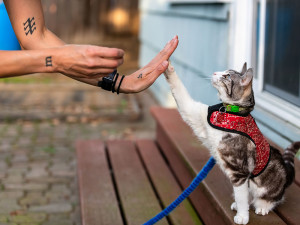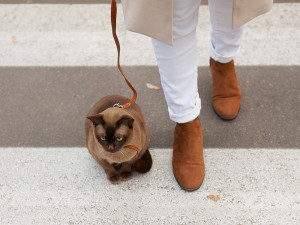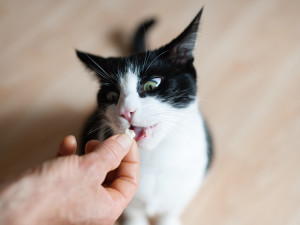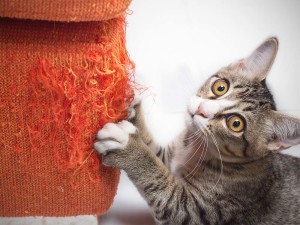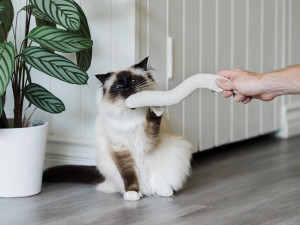Dream of High-Fiving Your Cat? Here’s How to Teach a Cat Tricks
It takes some patience (shocker), but it can be done.
Are you ever at a dinner party with friends, and they’re showing off all the cool tricks their dog can do? Do you, a cat parent, think, “There’s absolutely no way my cat would ever do anything this impressive?” You don’t think that because your cat’s not impressive; they’re the smartest being you know. It’s more that your cat doesn’t do anything on command because they are above doing tricks for treats, or so they’d like you to believe.
Cats are as trainable as they are adorable, and they are especially adorable when they show off their trainable nature with tricks. If you dream of a deeper connection with your cat and lots of fun together, imagine teaching them the best trick there is for celebrating and bonding together: the high-five. Who doesn’t want to high-five their cat in a figurative way? And how much better is it when you can do that and train them to high-five you in a literal way?
Teaching a Cat Tricks 101
To train your cat, use positive reinforcement. That means that good things (high-quality treats!) happen when your cat does what you want, but nothing bad happens if they don’t. Training is all about teaching them what to do. They are still learning, and they need us to be patient and consistent. It takes a lot of practice and many repetitions to learn any new skill, so give yourself (the teacher) and your cat (the student) a lot of grace. Your cat gets treats for getting it right, and they get a chance to try again if they don’t.
Save on the litter with color-changing tech that helps you better care for your cat.
What tricks can you teach a cat?
There are so many tricks you can train your cat to do. High-five is a top choice, but it is far from the only trick you can teach your cat. Some crowd-pleasing cat tricks are to weave through your legs, to “sit pretty,” to jump up on a chair, to go under your leg, to jump over your leg, to fist bump, to shake, and to spin. The tricks you teach your cat are mainly limited by your imagination. If you want to teach your cat to act like a statue on a shelf, to walk backwards, to wave, to go to a mat, or to jump through a hoop, you should!
What’s the best age to start teaching cat tricks?
You can start teaching kittens tricks as soon as you bring them home, but their attention spans will likely be very short. As they get older month by month and up to a year or more, it will be easier for them to stay focused and pick up new skills. Don’t be surprised if your young kitten can only stay with the program for 30 seconds or a minute before finding something else so fascinating they start wandering off or staring in the direction of some sound.
How much do you spend on your pet per year?
Once a cat is a year old or so, it’s more reasonable to expect them to pay attention for several minutes, or even 10 minutes at a time, as long as you work hard to keep them engaged, and they are earning treats for their efforts.
What can you expect when training your cat and how long does it take to teach a cat a trick?
Some cats learn fast, and in a just a few sessions, they are doing a new trick, but other cats take many days or weeks to catch on. So much depends on your skill as a trainer (including the timing of delivering clicks or treats and the decisions you make about when to advance to a harder task), how focused your cat is on the training, and how much experience your cat has learning new skills.
Once a cat has learned a few tricks, they are usually quicker at learning new ones because they have learned how to learn and understand that they need to do something to get the treats. They just need to figure out what that specific something is, but they already understand training in general.
How do you teach a cat to high-five?
To teach your cat to high-five, use treats to reinforce your cat for every step of the training process. The first step may not look a whole lot like high-five, but it is laying the foundation for the trick. Be generous with your treats, so you can be sure your cat gets the message that they are doing what you want them to do. Every time they get a treat for performing a behavior, you are making it more likely they will perform that behavior again.
Step By Step Guide
1. The first step is to teach your cat to put their paw on a sticky note when they are in a sit position. To do that, show your sitting cat a treat, put it on the floor, and cover it with a sticky note. When they use their paw to move the sticky note or to paw at it, give them the treat. (If you are using a clicker to train your cat — my preferred method — click and then give your cat the treat.) Once they reliably touch the sticky note with their paw, you are ready to start the next step in teaching them to high-five.
2. Next, put the sticky note on the palm of your hand and hold it on the ground in front of your cat. Every time your cat paws the sticky note, give them a treat, either right away or after you click, depending on the method you are using. Keep doing this until your cat is really good at it, and then raise your hand a few inches off the ground. Again, when your cat paws at the sticky note on your hand, reinforce that behavior by giving them a treat. In each training session, work at the level your cat is at, and if they are doing really well at that level, raise your hand a bit higher, getting closer and closer to a high-five.
3. Once your cat reliably paws at your hand at a variety of heights, they are ready to high-five you. The switch from a low-five to a high-five is not only about height. You also need to turn your hand so it is not parallel to the floor, but is upright. Put the sticky note on your palm, hold your hand so your fingers face up toward the ceiling, and present your hand to your cat. When they paw at the sticky note, give them a treat to let them know that they are doing something you like and want them do again. Repeat until they will reliably high-five your hand with a sticky note on it.
4. The last step is to fade the sticky note so they will high five your bare hand. Tear the sticky note in half, put one of the remaining halves on your palm, and present your hand to your cat to high-five. When they high-five you, they get another treat. Keep making the sticky note smaller and smaller until it is just a tiny scrap, reinforcing your cat for a high-five you at every size of the sticky note.
5. Only advance to a smaller piece when your cat is really good at high-fiving you with a piece of sticky note at a particular size. Finally, present your hand to your cat with no sticky note on it, and when your cat touches your hand with their paw, give them a treat for that high-five. Keep practicing without the sticky note so your cat gets really skilled at giving you a high-five, and then show this trick off to all your friends. (No, really, show them all what your amazing cat can do thanks to you.)
Common Problems
Training doesn’t always go exactly as planned, and it may be necessary to troubleshoot the process. Some cats will try touching the sticky note with their nose instead of their paw when you start raising it up. If your cat does this, lower your hand and get more practice at that lower height and then move it up in height more gradually than before.
The sticky note may flip and stick to your cat, but this is not a big deal. Just offer a treat as you pull it off, and move on to another training repetition right away. Some cats lose interest in the training session, and if that happens, make your next training session super short so you finish before your cat is “done.”
Tips for Cat Training
Your cat will have more success when learning any new skill if you follow these tips for training. These are aspects of training that apply when teaching your cat anything, including high-five.
Make the training sessions short and fun.
Cats have an easier time with training if you do it in lots of short sessions rather than occasional long ones. It’s most effective to have a few training sessions each day that last a minute or two rather than make them longer. Keep them fun by using treats. Use different treats — switching things up and introducing new treats at the start of a new session may result in a cat who is even more engaged and motivated.
End each training session on a positive note.
Always wrap up your training session after your cat has had some success. Great trainers are always looking for a good performance that indicates the successful end of a session. Don’t keep training because it’s going so well you just can’t stop. That risks a decline in performance as your cat gets tired, distracted, or becomes full of treats. The good feelings from the success at the end of the session are likely to stay with both you and your cat and will likely be the way you feel at the start of the next session. Happy feelings about training and its successes make future training easier and more effective, so it’s wise to cultivate those positive emotions by ending on a good note.
Don’t get discouraged if your cat doesn’t get it right away.
Training takes patience and persistence. Keep trying even if your cat doesn’t seem to catch on immediately. Remember that part of the value of training is the mental exercise your cat gets when working to figure this new skill out. Even if they are not performing the behavior you want just yet, the training process itself is valuable. Some cats pick things up right away and others take more time. And some cats learn gradually while others seem to have sudden flashes of insight where they suddenly improve a lot at once.
Are there any safety precautions I should take while training my cat?
It’s always important to keep your cat safe, and luckily, training is generally a safe activity. The main precaution to take is making sure your cat is not allergic to any ingredients in the treats you are using. It’s also wise to make sure no doors are open that could allow your cat to escape to the great outdoors or to let in a dog or another cat during training if that would upset your cat. It’s better to train your cat on carpeting or a mat rather than wood or tile floors because they might slip and land awkwardly, depending on what trick you are working on. Cats don’t slip that often, but it only takes once for a possible injury to happen, so it’s much better to avoid it.
FAQs
Is it OK to spray a cat with water?
It’s not OK to spray your cat with water because it’s mean. Any method of training that relies on pain, fear, or discomfort is unethical.
Is it too late to teach my cat tricks?
It’s never too late to teach your cat tricks. Cats of any age can be trained to do tricks.
To teach your cat tricks, make it fun and make it worth your cat’s while. That means use great treats, keep it light-hearted, and use only positive methods. Reinforce your cat generously, and keep in mind that training sessions are a valuable way to spend time with your cat. Training is great enrichment for our pets, and the time spent together is a wonderful way to both build your relationship and to celebrate it — perhaps with a perfectly executed high-five.




